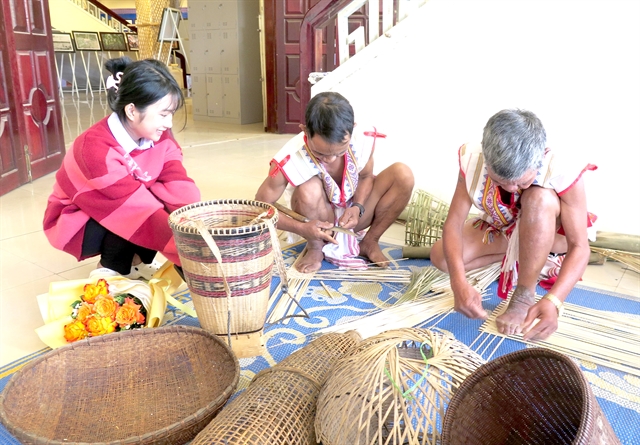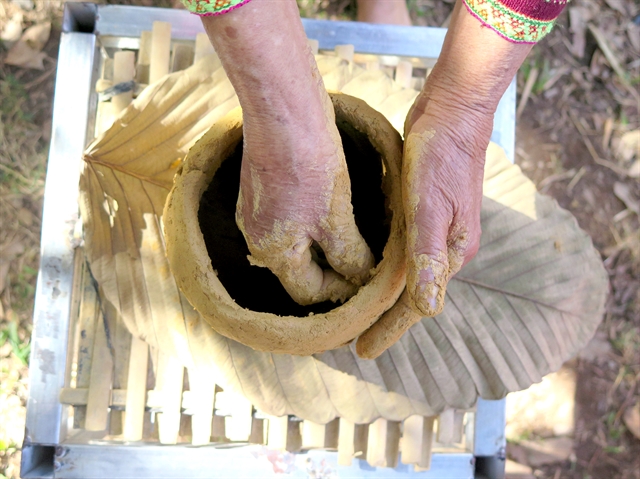The Kon Tum Province Party Committee issued the Resolution No 08-NQ/TU on promoting the traditional craft values of local ethnic groups with a vision to 2030.
 |
Artisans demonstrate the weaving craft of the Rơ Măm people. — VNA/VNS Photo Dư Toán |
KON TUM — Most artisans and people engaged in making traditional crafts in Kon Tum Province are getting old now, while the number of skilled people is decreasing, leaving risks of these valuable crafts being lost to time.
The Central Highlands province province is focusing on preserving and developing the tradition.
Kon Tum is home to seven ethnic groups including Xơ Đăng, Bahnar, J’Rai, Gié-Triêng, H’Rê, B’Râu and Rơ Măm, with nine traditional occupations of brocade weaving, weaving, making rice wine, making traditional musical instruments, forging, pottery, carving statues, carving dugout canoes and making crossbows.
In February 2022, at the sixth conference of the provincial 16th Party Committee, the committee identified many reasons leading to the risk of traditional occupations being lost.
In addition to the human factor, consumption of traditional men-made products is limited. Trade promotion and bringing traditional occupation products into tourism activities are not effective. Investment and raw materials development for traditional occupations preservation have not received due attention.
Therefore, the Kon Tum Province Party Committee issued the Resolution No 08-NQ/TU on promoting the traditional craft values of local ethnic groups with a vision to 2030.
The goal is to enhance the traditional craft values, preserve the ethnic groups’ fine cultural identity associated with tourism development, job creation and income improvement for the people, thereby effectively contributing to the national target programmes on socio-economic development in ethnic groups and mountainous areas, new rural area construction and sustainable poverty reduction.
Immediately after the Kon Tum Province Party Committee issued the Resolution No 08-NQ/TU, the provincial People's Committee approved the project 'Preserving and promoting the traditional craft values of local ethnic minorities with vision to 2030' and assigned the Ethnic Groups Committee to realise it.
Action
Head of the Kon Tum Ethnic Minorities Committee Đinh Quốc Tuấn said that the Ethnic Minorities Committee has created an archive for the community.
The committee collects documents on legends, anecdotes and historical records associated with the formation and development process of traditional craft products, reviewing and awarding titles to outstanding artisans and inserting some traditional crafts in extracurricular training programmes in schools in the area.
It also coordinates with departments and localities to organise vocational training in villages.
Up to now, districts and cities have organised 24 vocational training classes in villages and residential areas for young people, the core groups in cooperatives and households in Kon Tum City and Đăk Glei, Đắk Hà, Sa Thầy and Tu Mơ Rông districts.
The Kon Tum Department of Culture, Sports and Tourism also held ten classes to teach traditional hand weaving in the Xơ Đăng and Giẻ Triêng ethnic communities with 300 trainees.
Thanks to the efforts of authorities at all levels, organisations, individuals, and artisans, by the end of last year, Kon Tum Province had more than 13,800 people doing traditional crafts, an increase of more than 1,600 ones compared to the beginning of 2022.
“These are the first positive signs in preserving traditional crafts,” said Tuấn.
Programmes
 |
Demonstration of Bahnar pottery making. — VNA/VNS Photo Dư Toán |
As part of activities and practical programmes to develop the tradition, from December 26 to 30 last year, the Kon Tum Provincial Museum and Library organised a performance and exhibition of ethnic groups’ traditional crafts in the province.
Director of the Kon Tum Provincial Museum and Library Nguyễn Văn Quang said that traditional handicrafts were among important economic activities of the ethnic groups in the province.
Traditional handicrafts are honoured by the State as a type of intangible cultural heritage, containing many valuable folk knowledge values of individuals and communities, summarised over thousands of years of development and passed down from generation to generation.
However, in the era of scientific and technological development, the ethnic groups’ handicrafts and traditional products in the province are being strongly affected and increasingly fading away.
In the community, few people make and use traditional handicraft products.
“The provincial Museum – Library organises a programme to preserve, maintain and promote the values of intangible cultural heritage of traditional crafts, to introduce in-depth the typical traditional crafts of local ethnic groups to a large number of visitors, students, and cultural heritage researchers,” said Quang.
“In addition, it also creates conditions for artisans to have a space to practise, introduce the cultural heritage of the people and exchange with other ethnic groups,” he said.
Along with displaying products from traditional crafts, the museum – library held a performance space for traditional craftsmen to recreate products.
Meritorious Artisan Y Ber, who lives in Kon Săm Lũ Village, Đắk Tờ Re Commune, Kon Rẫy District, said that for the Bahnar community, pottery making had been one of the livelihoods for many generations.
Products such as rice bowls, drinking cups and cooking pots are created by the artisans’ skillful hands, helping the people, tourists and students to observe and learn first hand the complete process of creating ceramic products from the Bahnar people.
"For pottery making, the most important thing is to find good clay. We have to find and get clay from a stream more than a kilometre from our village. Currently, in Kon Săm Lũ Village, I am the only one who knows how to make pottery. I am very worried that the pottery making profession of the Bahnar people will be lost,” said Y Ber.
“Hopefully, through programmes like this, many people know about our pottery profession and buy our products. Then, many young people will learn how to make it and the profession will not be lost," she said.
Artisan A Klôi, from Mô Rai Commune, Sa Thầy District, demonstrates the weaving craft of the Rơ Măm ethnic group.
He said that in his village, only a few elderly people knew how to weave, because the younger generation is not interested in the craft.
Through the programmes, he hopes that the weaving craft of the Rơ Măm ethnic group will be learnt by more people.
Huỳnh Công Hưng, an 11th grade student at the Liên Việt Kon Tum Junior Secondary and High School, said that he was very excited to participate in the hands-on experience at the provincial museum, directly observing and learning about the process of creating traditional handicraft products by artisans.
“It will be very useful knowledge for me and my friends, better serving our learning process,” he said. — VNS



